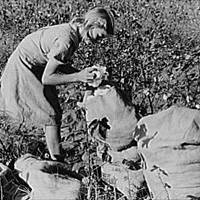 |

佃農的女兒正在棉花田中撿拾棉花 (1939年北卡羅萊那州使戴德斯威爾地區,由瑪麗昂‧波斯特‧沃考特所攝影)

|
 |
|
 |
棉子象鼻蟲 (Boll
Weevil) 在阿拉巴馬州受到表揚:1919年12月11日
到了1921年中期,棉子象鼻蟲已經擴散到南卡羅萊那州。這種小昆蟲對南方農人在1920年代的生活造成相當大的經濟困擾,在1930年代的經濟大蕭條時,情況更為嚴重。
一直到了1939年,農場安全管理局 (Farm Security Administration) 的攝影師瑪麗昂‧波斯特‧沃考特 (Marion Post Wolcott) 被派到北卡羅萊那州的威克郡 (Wake County) 注意到這種昆蟲引發的破壞,政府才開始重視。你覺得阿拉巴馬州的農人為什麼要幫這種昆蟲立碑呢?其中一個理由是因為這種昆蟲迫使農人停止對棉花的依賴,而改種其他農作物與製作農產品。
By mid-1921, the boll weevil had entered South Carolina. The tiny pest played a big part in the economic troubles of Southern farmers during the 1920s, and particularly during the Great Depression of the 1930s.As late as 1939, Farm Security Administration photographer Marion Post Wolcott, on assignment in Wake County, North Carolina, noted the damage that the insect caused. Why do you think the people in Alabama built a monument to this pest? One reason is because it forced residents to end their dependence on cotton and to pursue the farming of other crops as well as manufacturing.

 3/3 頁
3/3 頁
|





